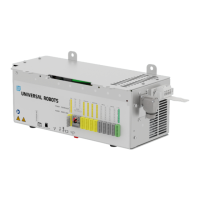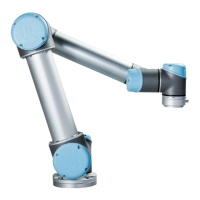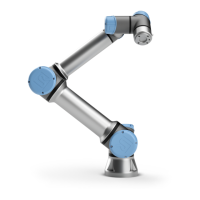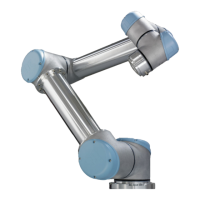OSSD
signals
All configured and permanent safety inputs are filtered to allow the use of OSSD safety
equipment with pulse lengths under 3ms. The safety input is sampled every millisecond and
the state of the input is determined by the most frequently seen input signal over the last 7
milliseconds.
OSSD
Safety
Signals
You can configure the Control Box to output OSSD pulses when a safety output is
inactive/high. OSSD pulses detect the ability of the Control Box to make safety outputs
active/low. When OSSD pulses are enabled for an output, a 1ms low pulse is generated on
the safety output once every 32ms. The safety system detects when an output is connected
to a supply and shuts down the robot.
The illustration below shows: the time between pulses on a channel (32ms), the pulse length
(1ms) and the time from a pulse on one channel to a pulse on the other channel (18ms)
To enable OSSD for Safety Output
1. In the Header, tap Installation and select Safety.
2. Under Safety, select I/O.
3. On the I/O screen, under Output Signal, select the desired OSSD checkbox. You must
assign the output signal to enable the OSSD checkboxes.
Default safety
configuration
The robot is delivered with a default configuration, which enables operation without any
additional safety equipment.
24V
EI1
24V
SI0
24V
SI1
24V
EI0
Safety
Safeguard Stop
Emergency Stop
Connecting
emergency
stop buttons
Most applications require one or more extra emergency stop buttons. The illustration
below shows how one or more emergency stop buttons can be connected.
24V
EI1
24V
SI0
24V
SI1
24V
EI0
Safety
Safeguard Stop
Emergency Stop
24V
EI1
24V
SI0
24V
SI1
24V
EI0
Safety
Safeguard Stop
Emergency Stop
UR30 77 User Manual
8.Installation
Copyright © 2009–2024 by UniversalRobotsA/S. All rights reserved.
